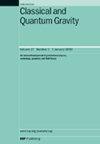Research on collision simulation and control strategies for test mass release under electrostatic control
IF 3.7
3区 物理与天体物理
Q2 ASTRONOMY & ASTROPHYSICS
引用次数: 0
Abstract
Space inertial sensors are crucial for space-based gravitational wave detection, requiring precise injection of test masses (TMs) into geodesic trajectories. However, conventional electrostatic suspension methods face challenges in capturing TMs with momentum exceeding . This study proposes a novel approach to mitigate TM release momentum by leveraging controlled collisions between the locking and release mechanism and the TM. A multi-body collision dynamics model, developed in MATLAB/Simulink, simulates the in-orbit injection process under space conditions, integrating low-speed collision contact detection and electrostatic interactions. The improved injection scheme employs momentum attenuation through plunger-TM collisions and utilizes electrostatic forces for orientation control, effectively expanding the allowable momentum range during release. Simulation results demonstrate that the strategy reduces TM momentum to capturable levels of 5 µm s−1 linear velocity and 150 µrad s−1 angular velocity within 300 s, even under non-ideal initial conditions. The collision-based method enhances injection reliability by addressing adhesion risks and momentum uncertainties, offering a robust solution for future gravitational wave detection missions.静电控制下试验质量释放的碰撞仿真与控制策略研究
空间惯性传感器对于天基引力波探测至关重要,需要将测试质量精确地注入测地线轨迹。然而,传统的静电悬浮方法在捕获动量超标的TMs方面面临挑战。本研究提出了一种新的方法,通过利用锁定和释放机制与TM之间的可控碰撞来减轻TM释放动量。基于MATLAB/Simulink开发的多体碰撞动力学模型,综合低速碰撞接触检测和静电相互作用,模拟了空间条件下的在轨喷射过程。改进的注入方案通过柱塞- tm碰撞来衰减动量,并利用静电力控制方向,有效地扩大了释放时的允许动量范围。仿真结果表明,即使在非理想初始条件下,该策略也能在300秒内将TM动量降低到5 μ m s−1线速度和150 μ rad s−1角速度的可捕获水平。基于碰撞的方法通过解决粘附风险和动量不确定性提高了注入可靠性,为未来的引力波探测任务提供了强大的解决方案。
本文章由计算机程序翻译,如有差异,请以英文原文为准。
求助全文
约1分钟内获得全文
求助全文
来源期刊

Classical and Quantum Gravity
物理-天文与天体物理
CiteScore
7.00
自引率
8.60%
发文量
301
审稿时长
2-4 weeks
期刊介绍:
Classical and Quantum Gravity is an established journal for physicists, mathematicians and cosmologists in the fields of gravitation and the theory of spacetime. The journal is now the acknowledged world leader in classical relativity and all areas of quantum gravity.
 求助内容:
求助内容: 应助结果提醒方式:
应助结果提醒方式:


